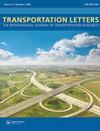Modeling motorcycle crash-injury severity utilizing explainable data-driven approaches
IF 3.3
3区 工程技术
Q2 TRANSPORTATION
Transportation Letters-The International Journal of Transportation Research
Pub Date : 2025-07-03
DOI:10.1080/19427867.2024.2408920
引用次数: 0
Abstract
Motorcycle crashes remain a significant public safety concern, requiring diverse analytical approaches to inform countermeasures. This study uses machine learning to analyze injury severity in crashes in Thailand from 2018 to 2020. Traditional and advanced models, including including random forest (RF), support vector machine (SVM), deep neural network (DNN), recurrent neural network (RNN), long short-term memory (LSTM), and eXtreme gradient boosting (XGBoost), were compared. Hyperparameter tuning via GridSearchCV optimized performance. XGBoost, with a tradeoff score of 105.65%, outperformed other models in predicting severe and fatal injuries. SHapley Additive exPlanations (SHAPs) identified significant risk factors including speeding, drunk driving, two-lane roads, unlit conditions, head-on and truck collisions, and nighttime crashes. Conversely, factors such as barrier medians, flashing traffic signals, sideswipes, rear-end crashes, and wet roads were associated with reduced severity. These findings suggest opportunities for integrated infrastructure improvements and expanded rider training and education programs to address behavioral risks.
利用可解释的数据驱动方法建模摩托车碰撞伤害严重程度
摩托车碰撞事故仍然是一个重大的公共安全问题,需要采取多种分析方法来制定对策。这项研究使用机器学习来分析2018年至2020年泰国车祸的伤害严重程度。比较了随机森林(RF)、支持向量机(SVM)、深度神经网络(DNN)、循环神经网络(RNN)、长短期记忆(LSTM)和极限梯度增强(XGBoost)等传统模型和先进模型。通过GridSearchCV进行超参数调优优化了性能。XGBoost在预测严重和致命伤害方面优于其他模型,权衡得分为105.65%。SHapley附加解释(SHAPs)确定了重要的风险因素,包括超速、酒后驾驶、双车道道路、无照明条件、正面和卡车碰撞以及夜间撞车。相反,障碍中间值、闪烁的交通信号、侧击、追尾碰撞和潮湿的道路等因素与严重程度降低有关。这些发现表明,有机会改善综合基础设施,扩大骑手培训和教育计划,以解决行为风险。
本文章由计算机程序翻译,如有差异,请以英文原文为准。
求助全文
约1分钟内获得全文
求助全文
来源期刊

Transportation Letters-The International Journal of Transportation Research
TRANSPORTATION SCIENCE & TECHNOLOGY-
CiteScore
6.40
自引率
14.30%
发文量
79
审稿时长
>12 weeks
期刊介绍:
Transportation Letters: The International Journal of Transportation Research is a quarterly journal that publishes high-quality peer-reviewed and mini-review papers as well as technical notes and book reviews on the state-of-the-art in transportation research.
The focus of Transportation Letters is on analytical and empirical findings, methodological papers, and theoretical and conceptual insights across all areas of research. Review resource papers that merge descriptions of the state-of-the-art with innovative and new methodological, theoretical, and conceptual insights spanning all areas of transportation research are invited and of particular interest.
 求助内容:
求助内容: 应助结果提醒方式:
应助结果提醒方式:


